Mexico City: Bosque de Chapultepec botanical garden and more
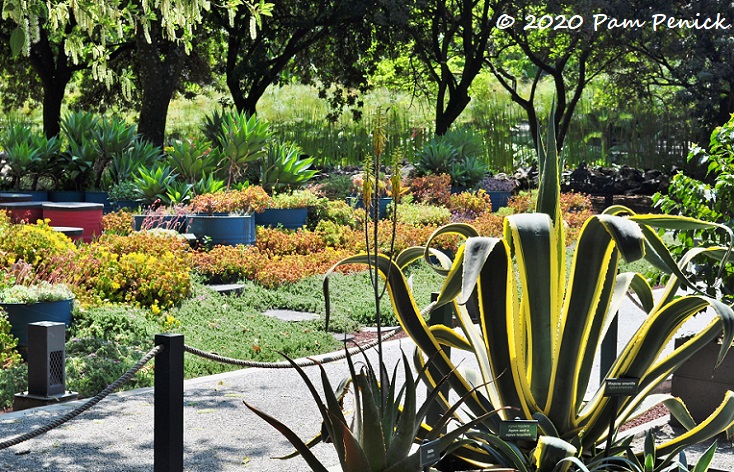
One morning during our stay in Mexico City we explored the city’s “lungs”, the Bosque de Chapultepec, or Chapultepec Forest. At 1,695 acres, it’s one of the largest city parks in the Western Hemisphere. Chapultepec means “grasshopper hill” in the Aztec language, and in fact the park does contain a tall hill — a rare sight in flat Mexico City, which is built upon a drained lakebed.
Tucked into Chapultepec park is a small botanical garden, only 13 acres, but an interesting one. A recent article by Wildflower editor Amy McCullough about the jardín botánico had piqued my interest, and we soon found it. Happily, admission is free.
Cinderblock succulents
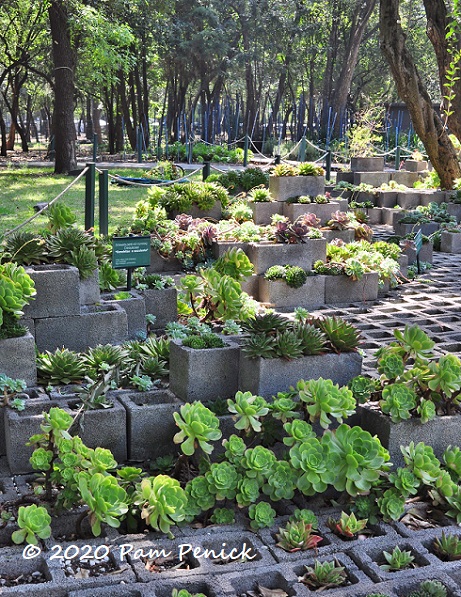
We strolled in, and I smiled to see this: a long border of cinderblock-planted succulents — much like my own (much smaller) cinderblock wall planter!
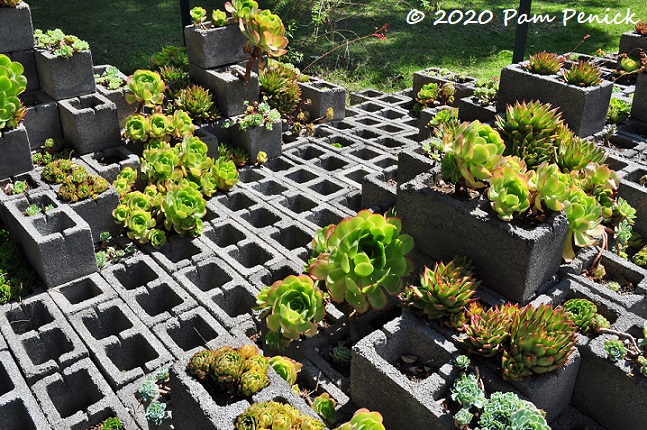
Hundreds of cinderblocks laid end-to-end and stacked into miniature modernist towers hold echeverias galore.
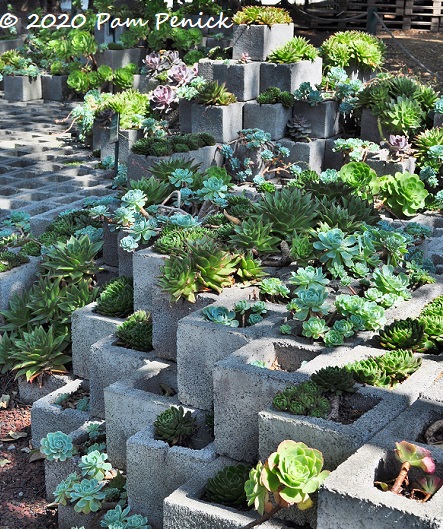
The creative display makes for a fun moment as you arrive.
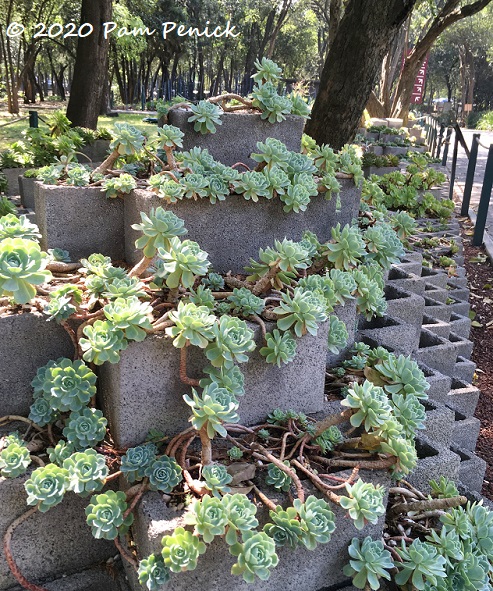
Echeveria is native to Mexico, making it a perfect plant to greet visitors.
Pallet fort
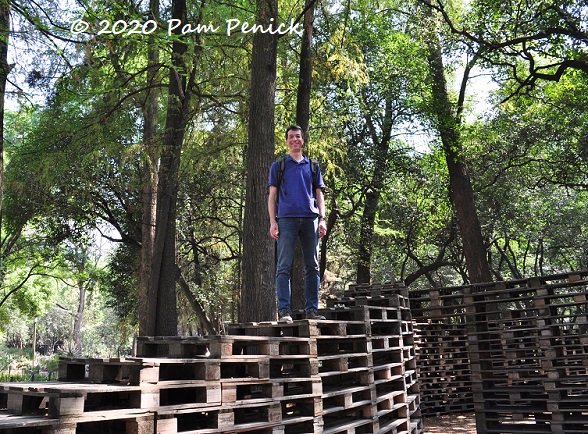
Next we came across a fort-like structure made of wooden pallets. Stacked about 8 feet high, they invite climbers with stair-stepped construction.
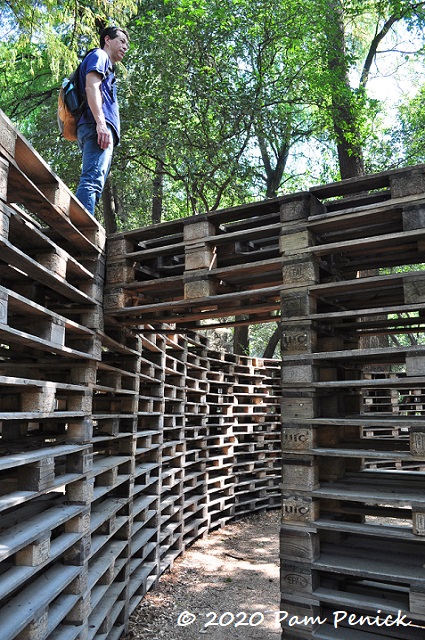
Curved walls, doorways…
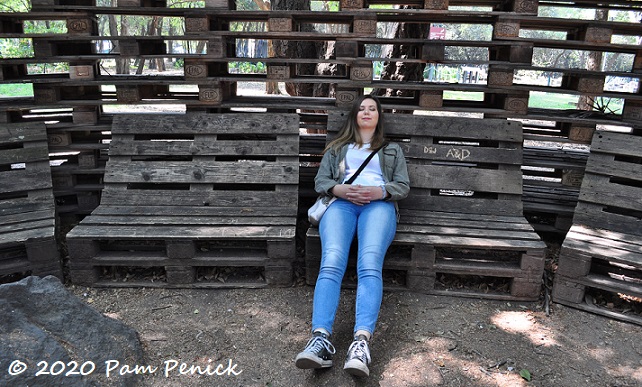
…and benches — this place is made for play and relaxation.
Xeric garden
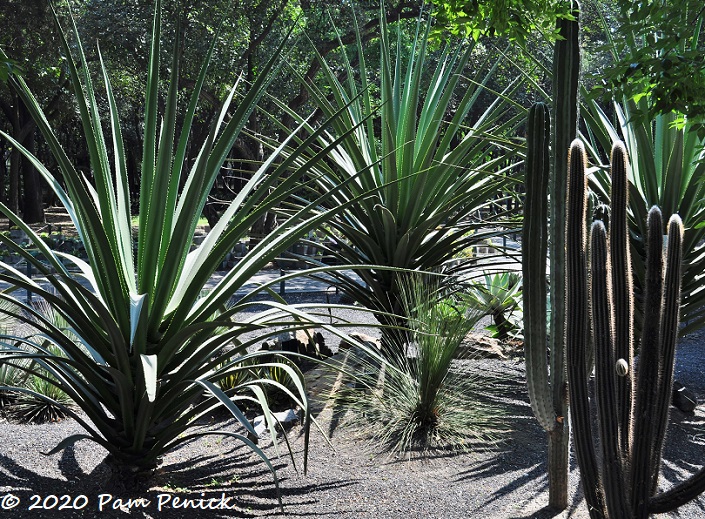
A gravel garden studded with rocks showcases toothy, agave-like plants — Furcraea macdougallii — and cactus.
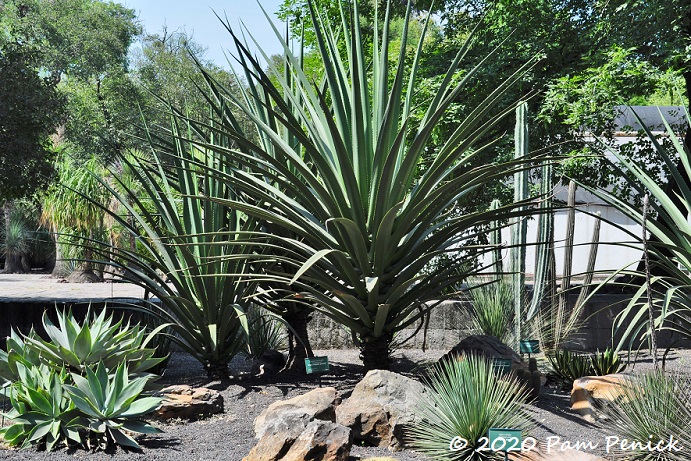
And agaves too. I believe these are all Mexico native plants.
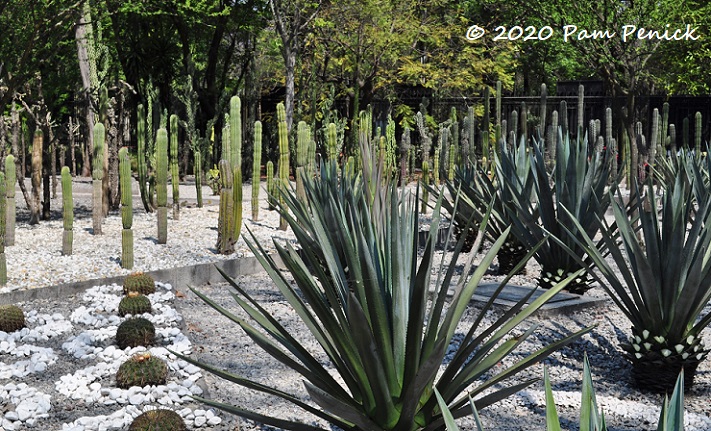
As with the native plant garden at Plaza del Marqués, a modern grid layout and pineapple-pruned agaves distinguishes the xeric garden.
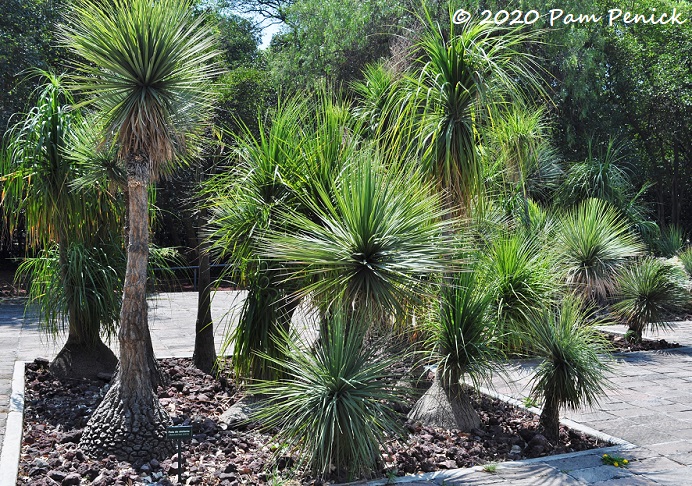
Beaucarnea stricta, or elephant’s foot, with spiky, punk-rock hairdos.
Edible seed display
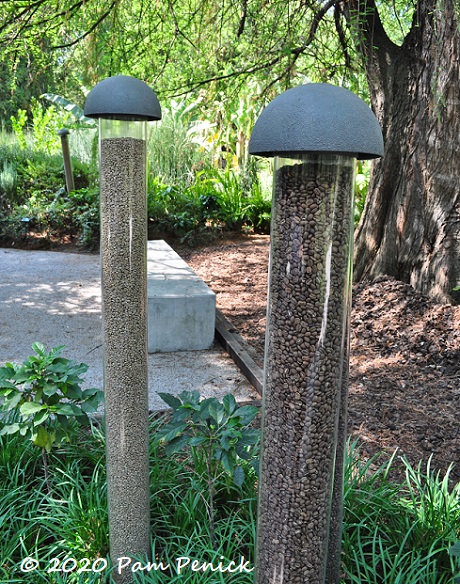
One section of the garden features plants with edible seeds, showcased in tall, see-through cylinders — like storage containers in your pantry, perhaps.
Wetland garden
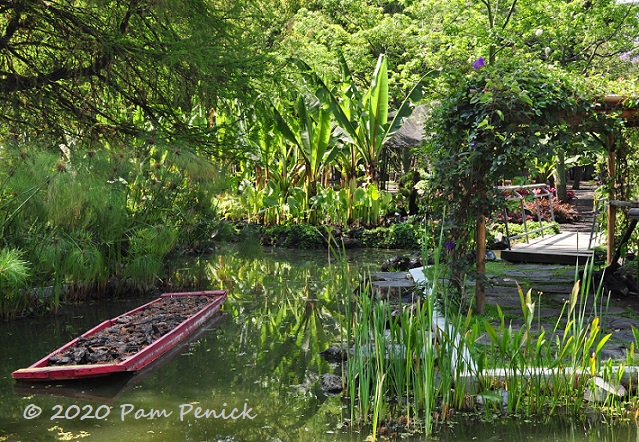
A wetland garden features a pond with a flat-bottom boat. I wonder if the boat is planted up later in the season.
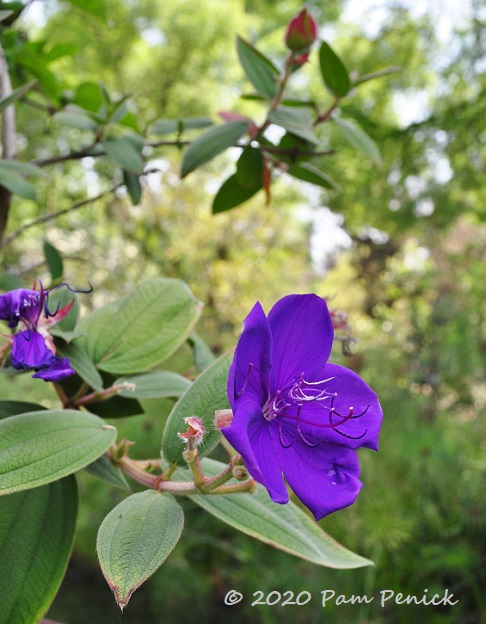
Tropical-looking flowers and banana trees in this garden contrast mightily with the xeric garden of cactus and agave.
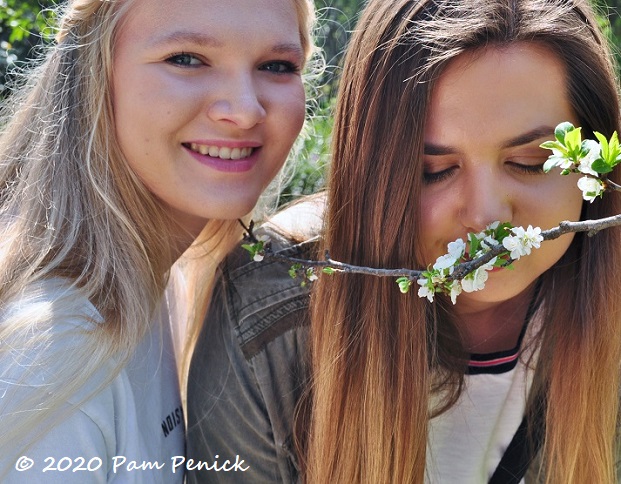
The girls stopped to smell the flowers.
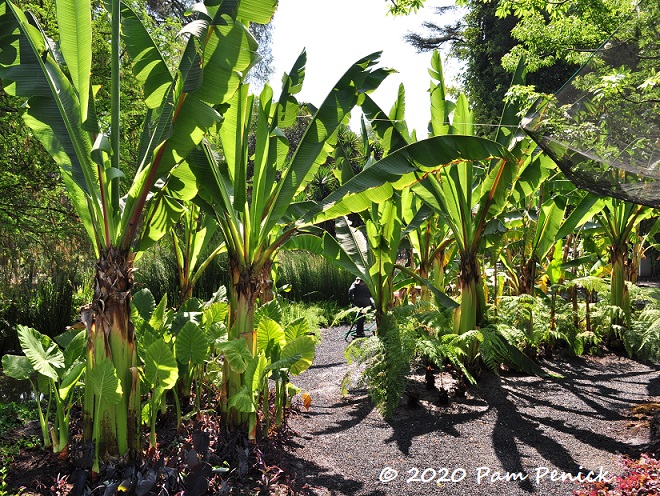
Banana trees and their shadows add drama along gravel paths.
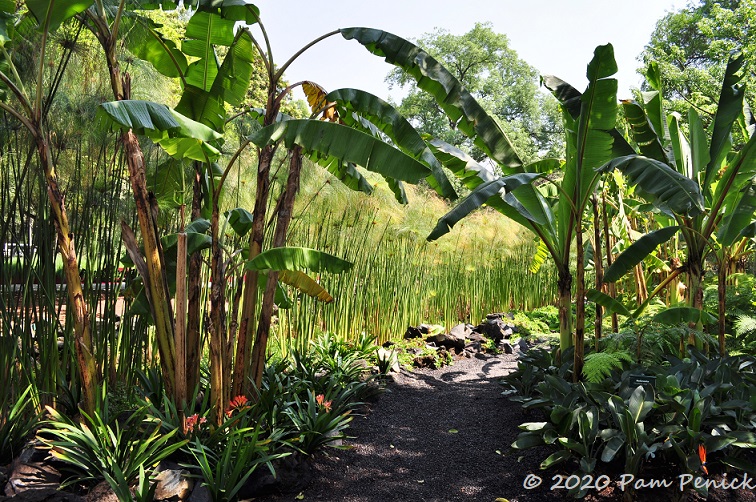
Shazam! A banana leaf arbor and “hedge” of giant papyrus, with orange-flowered clivia making a pretty groundcover.
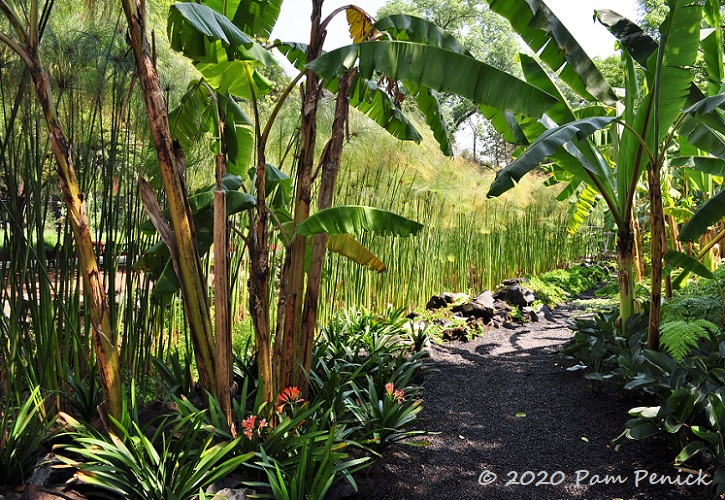
One more
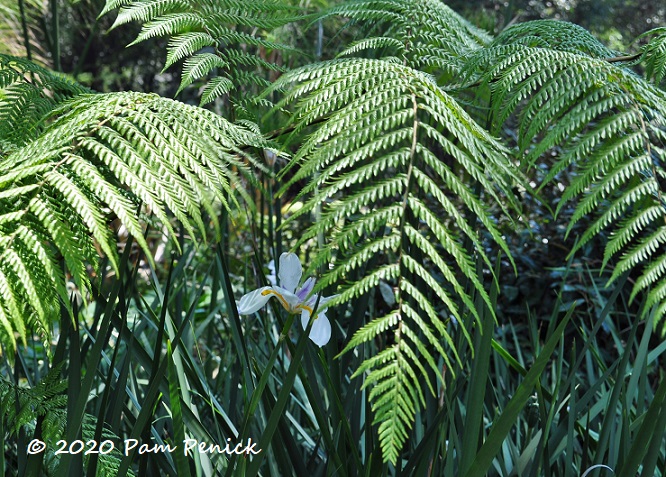
Fern and iris
Grass(hopper) garden
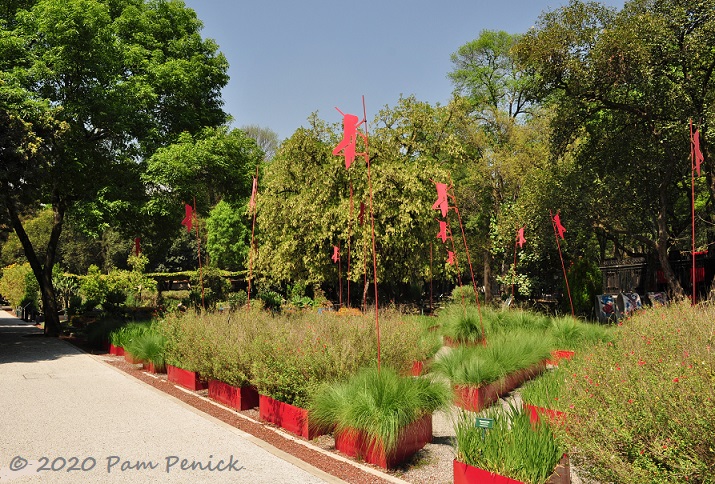
Deeper into the garden we came across this interesting space: a grassy garden planted in red steel planter boxes — like an atomized meadow — with red grasshopper silhouettes atop long poles. What a fun play on “Chapultepec,” which, if you’ll remember, is Nahuatl (Aztec) for “grasshopper hill.”
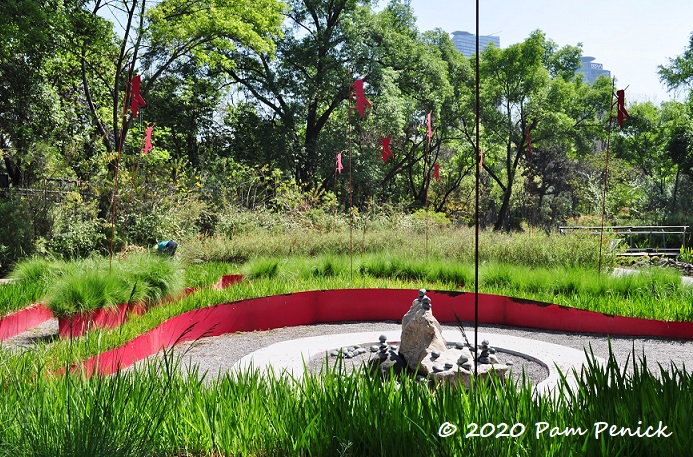
The red planter boxes wind river-like around a circular focal point of boulders and stacked beach pebbles.
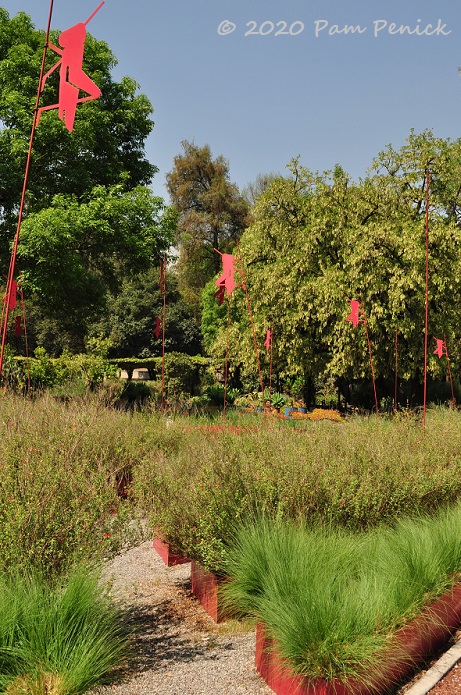
You can walk through the “meadow” via gravel paths.
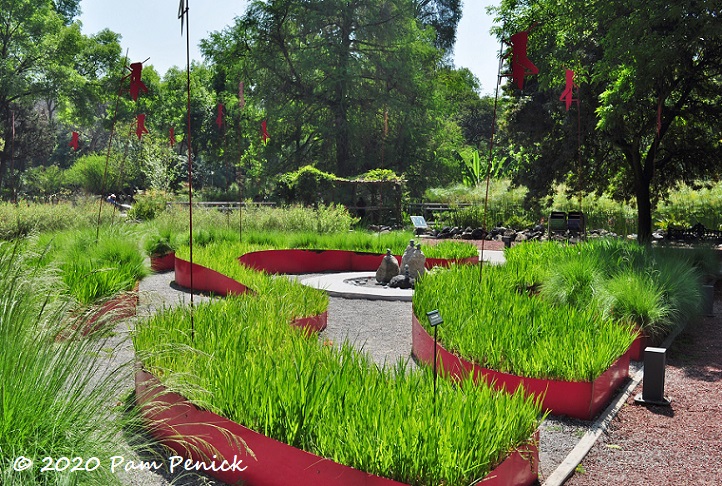
The color, the undulating lines, the grasses and grasshoppers — I enjoyed exploring this garden space.
Culvert pipe accents
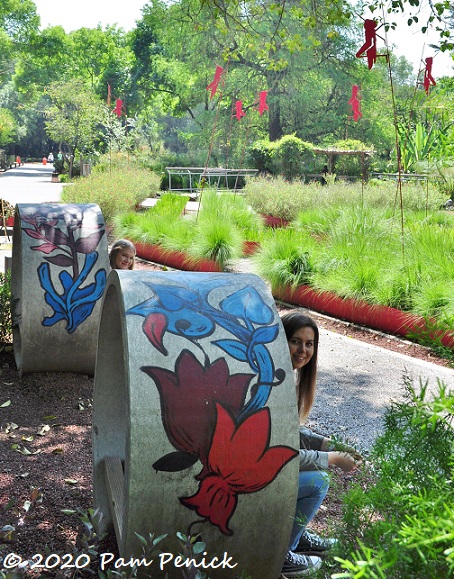
Benches tucked inside painted concrete culvert pipes offer a spot to rest and take in the view.
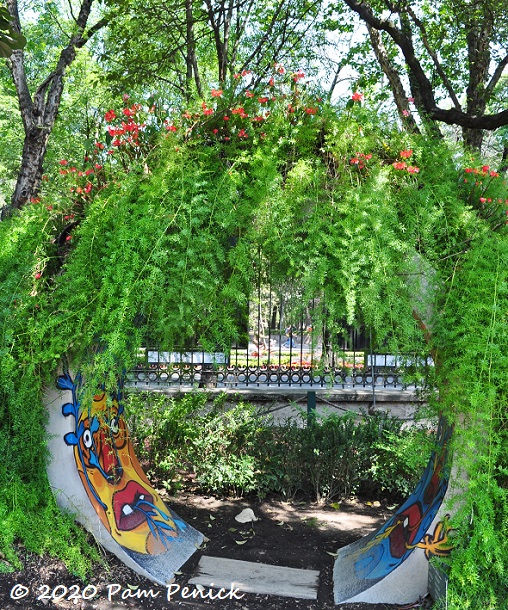
A bigger pipe segment makes an arch smothered in ferny greenery.
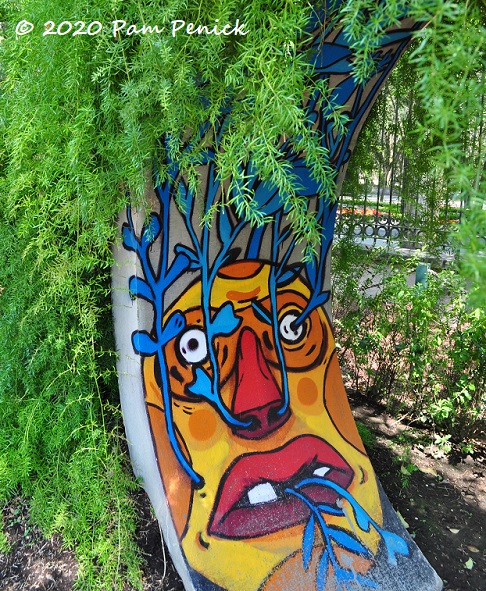
Painted face in the culvert arch
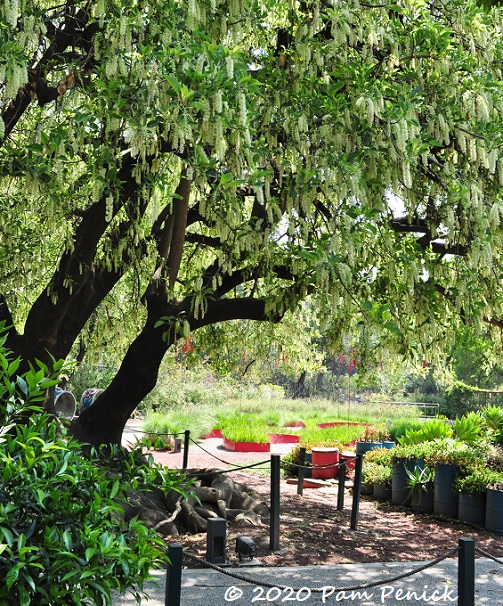
Flowering tree arching over the scene.
Oil drum succulent garden
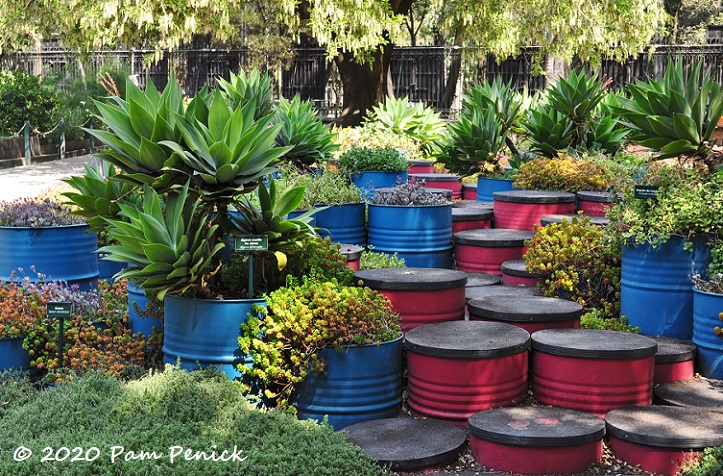
At the rear of the garden, another playful display appears: oil drums painted red and blue, installed at varying heights to create a path and planters filled with agaves and small sedums.
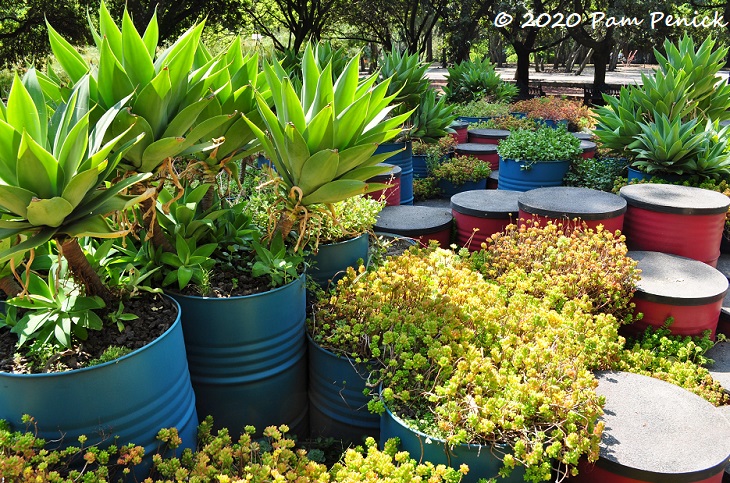
The blue-drum planters overflow with bold agave foliage and tendrils of golden sedum. The red drums, fitted with stepping-stone lids, invite you on a dancing journey through the space.
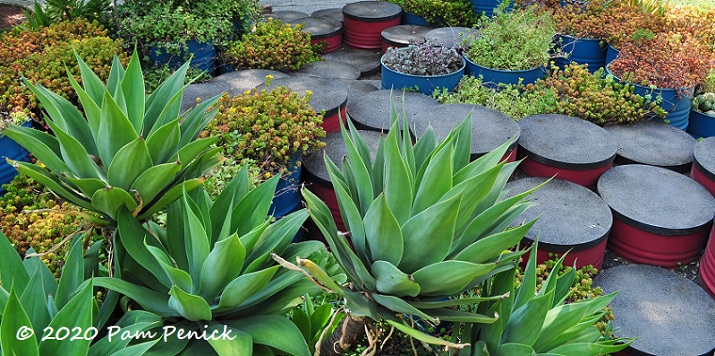
It’s the kind of garden a creative recycler might make.
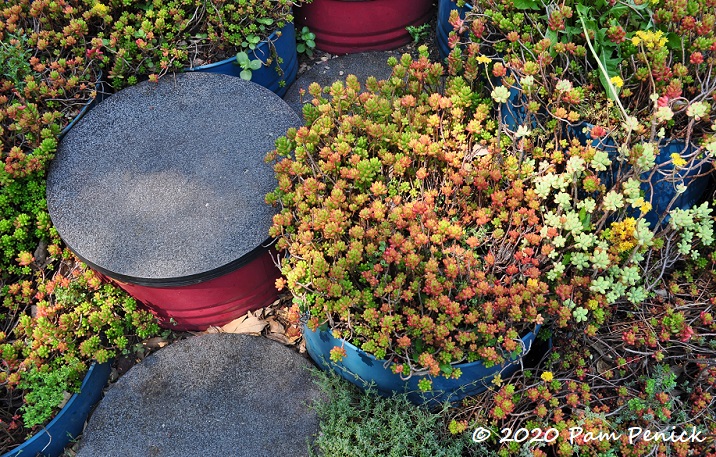
Standing atop the drum path, you get a nice view of both the containers and the surrounding garden.
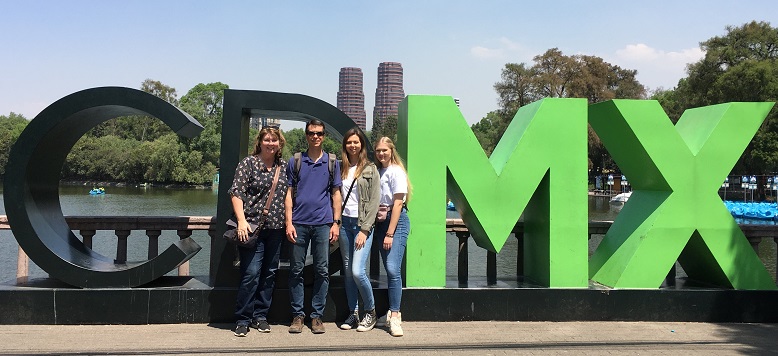
There’s a lot more to see in Chapultepec park than just the botanical garden, of course, including a paddle-boating lake, a castle, a zoo, museums, and monuments. We wandered for a few hours and posed in front of a giant CDMX, the acronym for Ciudad de Mexico (Mexico City). Then we headed over to the celebrated National Museum of Anthropology.
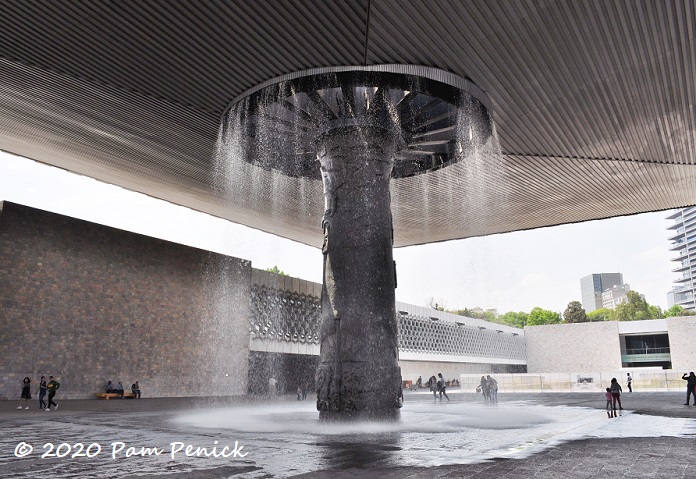
Museo Nacional de Antropología wowed us with its Umbrella, a sculptural column supporting a vast, asymmetrical roof, with a waterfall sheeting from the ceiling onto the plaza below. According to the museum’s website, the hanging roof is among the largest in the world and is supported by cables above the roof.
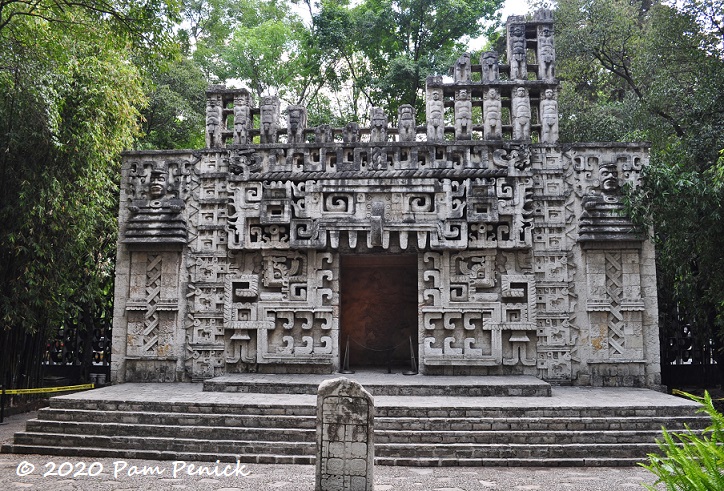
The museum’s vast collection of pre-Columbian artifacts is wonderfully displayed and tells the stories of Mexico’s peoples. Tucked into leafy courtyards accessible from some of the display rooms are also reproduction Mayan or Aztec temples, like this one, which you can explore.
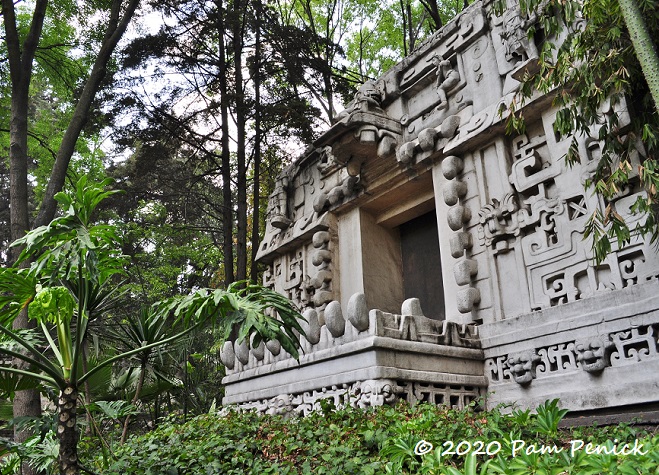
We spent about 3 hours at the museum and saw only a tiny fraction of its offerings. Isn’t that always the way it is with museums you visit while traveling? There’s never enough time or energy to see it all. You must be a local to really have a chance to see everything. The lesson I take from that is, be a tourist in your own city and visit and revisit your own local museums and attractions.
Up next: Exploring lovely San Ángel and Condesa neighborhoods. For a look back at the colorful folk art of Museo de Arte Popular, click here.
__________________________
Digging Deeper
Come learn about gardening and design at Garden Spark! I organize in-person talks by inspiring designers, landscape architects, authors, and gardeners a few times a year in Austin. These are limited-attendance events that sell out quickly, so join the Garden Spark email list to be notified in advance; simply click this link and ask to be added. Season 8 kicks off in fall 2024. Stay tuned for more info!
All material © 2025 by Pam Penick for Digging. Unauthorized reproduction prohibited.


Your posts of MCDX really take me back to our 1982 visit and stay. The garden botanic in the park may not have been there in ’82, because I don’t remember it at all. I do remember the Antropología, though. We had a good lunch in their cafeteria. Thanks for the memories.
You’re welcome, Peter. According to the garden’s website, “[T]he Chapultepec Forest hosted the first botanical garden in the country, forming through collections of exotic plants that were brought from different parts of the country. The new garden was inaugurated in 2006, built in a space of 5.3 hectares.” So it seems there was an original botanical garden, but the current one is newer, and it was revamped in 2018.
What a wonderful and fun place. How great that you were able to visit there and have those memories before our current crisis kicked off. Thank you for sharing the memories with us.
I’m grateful for that too, Dorothy. Thanks for commenting.
I enjoyed this post tremendously, Pam. I’m surprised at just how much I like that sprawling cinderblock succulent display, perfect for spots where the ground is hard to dig, like parts pf my back slope…
Absolutely, Kris. And a cinderblock planter wall can be configured in so many different ways to suit the space.
I was really struck by the artful repurposing of “throw away” and low cost materials in the garden–the pallets, the oil drums, the cinder blocks, even the concrete drain pipe pieces. The whimsical metal cutout grasshoppers was an unexpected playful touch. The design was very thoughtful and creative. I’m not sure why I would be surprised, but with all the bad news about corruption in Mexico and drug cartels, I guess my expectations are low that people can organize and produce beauty for public places. I’m glad people persevere despite whatever hardship. A lesson for us all, resassurance maybe, especially now. Gardens continue to be a source of inspiration and escape, no matter what’s going on in the world. I know this time next year, my garden will be very different (and for the better), as the current events have prompted me to get going on some ideas I’ve been mulling over for some time. From the bad, good emerges if we make the effort.
I agree, Beverly. As you put it so well, the designers have cleverly repurposed commonplace, industrial objects to create these unique garden spaces. Mexico has its challenges, for sure, but creating beauty isn’t one of them. Its capital city is filled with beautiful parks, architecture, and art. And yes, as we stumble along through these troubling times, that ought to provide hope for us all. Happy revising in your own garden!
My son has just moved to Mexico City from La Paz-he is a world traveler. It was surreal finding your site for the first time last week and reading about the Jacaranda Trees. Then that weekend receiving my sons instagram Standing under them!! Seeing your wonderful photos we can’t wait to visit as soon as current situation ends…
Oh, that’s so cool! You’ll have a great visit to CDMX, I am sure, once our traveling days return.
Purple flower might be Tibouchina?
Looks like it. Thanks, Diana.